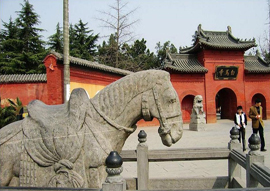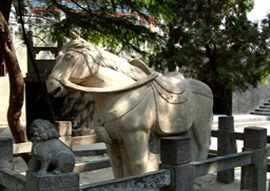The White Horse Temple (Baima Temple) is located 10km to the north of Luoyang in Henan Province. It is said, in the year of King Yongping of Eastern Han Dynasty (25 - 220 AD), the king sent monks Cai  Yin and Cai Jing to India to ask for scriptures of Buddhism. Three years later, they got the scriptures and returned to China. Yin and Cai Jing to India to ask for scriptures of Buddhism. Three years later, they got the scriptures and returned to China.
During the return trip, they met monks She Moteng and Zhu Falan near the north of Afghanistan. The two monks took a white horse to help them transporting the scriptures back to Luoyang. The year after they returned, a temple was built to keep those scriptures, that is the White Horse Temple. The White Horse Temple was the first temple built by the government after Buddhism of India reached China, so people also called it "Grandfather of the Temples". This temple was quite giant in Tang Dynasty (618 - 907 AD). Today, after years of warfare, less than ten percent of the construction is remained. It includes the Tian Wang Hall, Dafo Hall, Da Xiong Hall, Jie Yin Hall, Pilu Garret, and Qing Liang Stand.
There are three Buddha Statues in the Da Xiong Hall : Sakyamuni, Yaoshi, and A Maitreya. The most valuable items in the hall are the sculptures of the Eighteen Disciples of the Buddha, made during the Yuan Dynasty (1277 - 1367 AD). On the wall, there are more than 5,000 shrines of wooden Buddha statues. There is also a 1250kg weight giant bell in the temple. Every morning and evening when the Buddhists are having their lessons, you can hear the loud and clear ring of the bell. Since ancient times, the bell ring of the White Horse Temple is one of the famous events in Luoyang.
The Qing Liang Stand in the temple is also famous. People believed monks She Moteng and Zhu Falan from India once translated scriptures here. They stay at the temple and regarded as their home  until they die, people buried their bodies beside the temple and that is today's Two Monks' Tomb. Many Tang scripture monuments and Yuan inscriptions are important documents for scholars to study the history and evolution of Buddhism. There is a 24m-high pagoda in the temple named Qi Yun. It has four angles and thirteen floors, originally built in the Tang Dynasty (923 - 936 AD), and destroyed in the Song Dynasty but rebuilt in 1175 AD. until they die, people buried their bodies beside the temple and that is today's Two Monks' Tomb. Many Tang scripture monuments and Yuan inscriptions are important documents for scholars to study the history and evolution of Buddhism. There is a 24m-high pagoda in the temple named Qi Yun. It has four angles and thirteen floors, originally built in the Tang Dynasty (923 - 936 AD), and destroyed in the Song Dynasty but rebuilt in 1175 AD.
There are a pair of white horses and a pair of lions at the gate of the temple. They symbolize "if you are going to study the deep knowledge of Buddhism, you should have a great deal of perseverance and willpower, and you shouldn't be afraid of difficulties". They have been standing at the gate and accompanying the temple for more than a thousand years. In 1961, it became one of the important preservations of cultural relics of the State.
When you are traveling around Luoyang, you should not ignore such and important Buddhism scenic spot with a thousand years'history. |
